I am still working through the locations featured in the 1973 Architects’ Journal “New Deal for East London” special issue where a range of locations, deemed to be at possible risk from future development were identified.
My first post on this subject with the full background to the 1973 article can be found here.
For today’s post I am in Mile End and Stepney Green, tracing the sites numbered 44 to 48, 61 and 62 as shown in the following map extract from the 1973 article (I covered site 46, the church of St. Dunstan’s a couple of weeks ago).
The Architects’ Journal identified Stepney as a Medieval Village Centre, but one that had been absorbed by the growth of east London over the past couple of centuries. I have reproduced the same locations in an up to date map, shown below, from OpenStreetMap.
There is so much history in this area that a much longer post is needed to cover fully, so my focus for today is seeing how many of the 1973 Architects’ Journal locations remain, and their current condition.
My first location was in Mile End Road:
Site 44 – 1695 Trinity Almshouses
The Trinity Almshouses were built in 1695 by the Corporation of Trinity House for “28 decayed Masters and Commanders of ships or ye widows of such”. The land for the almshouses was donated by a Captain Henry Mudd and they consist of two rows of cottages either side of a green, with a chapel at the far end of the green.
For many years after construction, the almshouses were in a very rural Mile End. The following extract from John Rocque’s map from 1746 shows the almshouses in the centre of the map, surrounded by agricultural land and fields.
The roads leading north from Mile End Road, either side of the almshouses have some interesting names. Dog Row on the left (now Cambridge Heath Road) and Red Cow Lane on the right (now Cleveland Way). Mile End Road leading through Mile End Old Town was a wide street here in 1746 as it is today.
Captain Fishers Ale House is at the end of Dog Row (I wonder how many of the decayed Masters and Commanders of ships frequented the ale house), and a Turn Pike could be found across Mile End Road opposite Dog Row.
The following engraving from Chamberlain’s History of London published in 1770 shows a rather impressive view of the almshouses as they appeared at the time.
The almshouses have been under threat many times since 1695. The Corporation of Trinity House petitioned the Charity Commissioners for permission to demolish the almshouses in the 1890s, permission was refused.
They suffered bomb damage during the last war, but were repaired by the GLC, with the chapel being fitted with 18th century paneling from a house in Hammersmith.
Spitalfields Life has documented the recent threats to the almshouses
Where they reach Mile End Road, the two rows of cottages are terminated by rather ornate gable ends:
A plaque on the gable ends records the origins of the almshouses:
In the 1770 engraving, some rather impressive model ships can be seen on the gable ends. Model ships can still be seen today, however these are now fibreglass replicas with the original marble models being stored in the Museum of London.
The almshouses feature in the top right of this mural by Mychael Barratt which can be found a short distance from the almshouses:
There is also a statue to William Booth, founder of the Salvation Army which was unveiled in 1979:
And rightly there is also now a 2015 statue to Catherine Booth to acknowledge their joint enterprise to setting up the Salvation Army:
To show just how much can be found in this short distance along Mile End Road, further along can be found this entrance to a car park and a number of businesses, however the wall on the left records an example of the type of destruction that the Architects’ Journal was so concerned about.
In 1958, fifteen years before the article was published, the site of the wall was occupied by the house that Captain James Cook occupied for a number of years in the 18th century.
The buildings either side of Cook’s house were not demolished, the apparent reason for the demolition was to widen the lane, but there was no reason then, or today, for a wider lane leading off here from Mile End Road.
It is a perfect example of the random demolition that took place in the decades after the 1940s that Cook’s house was destroyed, but the adjacent terrace of buildings was left in place, which is my next location:
Site 61 – Late 18th Century Terrace
Running to the east along Mile End Road from the location of Cook’s house is this row of late 18th century buildings:
The terrace consists of a fascinating mix of different architectural styles and modifications to the buildings. In the following example, a bay window on the first floor extends over Assembly Passage – a long, cobbled walkway that leads from Mile End Road to Redmans Road.
Across the road is the Genesis Cinema – a restored cinema (which originally opened in 1912) in a location that had been occupied by a pub, theatre and palace of varieties.
A short distance along Mile End Road from the cinema is the next Architects’ Journal location:
Site 48 – Early 18th Century Group
A lovely group of four terrace houses – it took a while to get this photo without any traffic, there is a continuous stream of traffic along Mile End Road.
Further along Mile End Road is:
Site 62 – Early 18th Century Group
A pair of large 18th century houses, set back from the road with small gardens between house and street.
To the right of the buildings is a Topps Tiles warehouse and on the left is a small open space, then the new buildings on the site of the old Anchor Brewery.
The Architects’ Journal definition for this site was a ‘Group’ rather than a ‘Pair’ so I do wonder if there were additional houses in 1973 and this pair are all that remain.
The following location was not so lucky:
Site 45 – Mutilated Early 18th Century Group
To reach my next destination I turned off Mile End Road, a short distance along Stepney Green, along Hannibal Road to Redmans Road to see if this early 18th century group remained.
If my reading of the Architects’ Journal map was right, then the terrace should have been in this location – space now occupied by the expanded playground of the Redlands School.
The houses in 1973 must have been in some state as the Architects’ Journal description was the rather strong “mutilated group”. I checked on the excellent London Metropolitan Archives Collage image archive and found this photo from 1971 of a terrace of houses along 42 to 48 Redmans Road – the space now occupied by the playground extension.
Image credit: London Metropolitan Archives, City of London: catalogue ref: SC_PHL_01_397_71_642
The boards to the side of the doors on the central houses indicate that the houses were used in the clothing trade, with the board on the right advertising machinist vacancies.
I am sure this is the right location as to the left of the above photo, the edge of a post war terrace of flats can be seen, which are still there today as shown in my photo below.
I assume the description of mutilated indicates that the buildings have been considerably changed from their original 18th century design and structure.
I then turned back along Redmans Road to the next location:
Site 47 – Early 18th Century Remains At Stepney Green
Mile End Road is very busy, with what seems like endless traffic streaming both into and away from the City. Walk the short distance to Stepney Green and the environment changes completely. I walked through Stepney Green on a cold grey day in February and a warmer, but still grey day at the end of April, when the trees were coming into leaf and bird song was louder than the distant traffic.
The main part of Stepney Green consists of two parallel streets with central gardens running between them. The eastern street is narrow and it is along this street where the majority of the older buildings are located.
In 1746, John Rocque’s map included what would become Stepney Green as a wide area running south from Mile End Road with houses mainly on the eastern edge. Houses with large back gardens with a large open field behind. In 1746 the area was called Mile End Old Town rather than Stepney Green.
This is the view down the eastern side of the central green.
The layout from 1746 can still be seen today as the 1746 map indicates a narrow street in front of the houses to the east, trees along the centre with a wider road on the western side – the same layout can be seen today.
The central gardens are tree-lined on either side with a pathway winding through the middle.
The Architects’ Journal map shows houses on either side at the northern end of Stepney Green with additional houses marked on the eastern side. This distinctive terrace of four houses is along the northwest corner.
The houses along the eastern edge tend to be larger, more individual buildings.
One of the most important buildings in Stepney Green is number 37 – a magnificent Queen Anne house that was built in 1694. The house was purchased by the Spitalfields Trust in 1998 who restored the house from institutional use to a rather magnificent family dwelling.
Number 37 Stepney Green:
A closed pub on the western side of Stepney Green that has been converted to a private residence. Originally the Ship, then for a few years before closure, the Ship on the Green:
The LMA Collage archive has a photo of the Ship as it was in 1953:
Image credit: London Metropolitan Archives, City of London: catalogue ref: SC_PHL_01_399_F8790
The view across Stepney Green.
In the above photo, the house to the left of middle has an interesting plaque above the door. The house must have been occupied by a dispensary at some point as the plaque records that the equipment for the dispensary was provided by a fund raised by the Mayor of Stepney in memory of King Edward VII, for the prevention of consumption.
The corner of Stepney Green and Cressy Place is occupied by Dunstan Houses, built by the East End Dwellings Company Ltd in 1899:
The East End Dwellings Company was formed in the early 1880s by the vicar of St. Jude’s, Whitechapel, the Reverend Samuel Augustus Barnett. The intention of the Company was to provide housing for the poor, including those who other philanthropic housing companies often avoided, such as casual, day labourers.
Another of the large housing developments by late Victorian philanthropic companies can be found towards the southern end of Stepney Green.
Stepney Green Court was built by the Four Per Cent Industrial Dwellings Company. The name of the company came from the plan that a four per cent return could be made on the investment needed to construct good housing which could be provided at an affordable rent.
Stepney Green Court was built in 1895.
The building features some very ornate decoration:
Towards the end of Stepney Green, where the central gardens and eastern side road have ended, is the remains of an interesting building.
On a small corner of the main Stepney Crossrail construction site are these brick walls and ornate entrance:
These are the remains of a Baptist Chapel. The Crossrail Architectural and Historical Appraisal identifies the walls and door as the remains of a Baptist Chapel, possibly built around 1811.
The LMA Collage archive has a photo of the area showing that the remains of the Baptist Chapel were in a poor state in 1969.
Image credit: London Metropolitan Archives, City of London: catalogue ref: SC_PHL_01_399_69_3379
All the buildings on the left have been demolished and the whole area is now a Crossrail construction site.
Entrance to the construction site:
With the exception of the “mutilated early 18th century group” in Redmans Road the buildings listed in 1973 have survived well. The houses along Mile End Road face onto a very busy road into the City, however turn off Mile End Road into Stepney Green and you can find one of those historic landscapes that London conceals so well.
It will be interesting to see what happens to the remains of the Baptist Chapel and the construction site, once work is completed – hopefully something that blends in with the area rather than bland apartment buildings that can be found anywhere across the city.
A the end of Stepney Green is the large churchyard and church of St. Dunstan and All Saints.


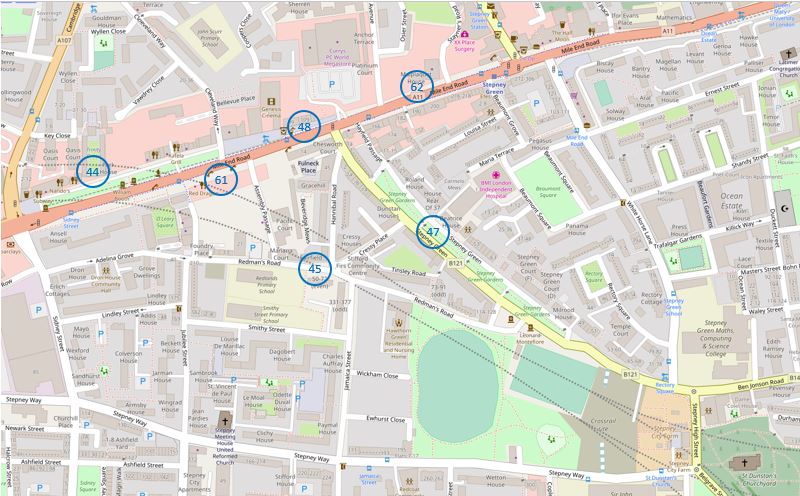


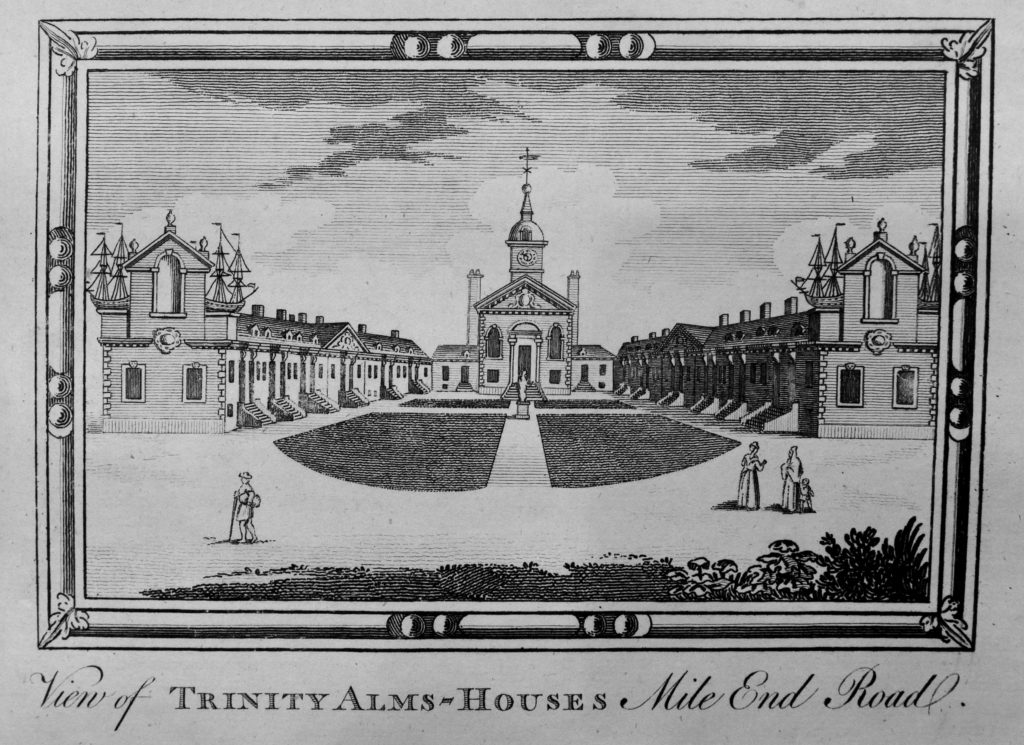
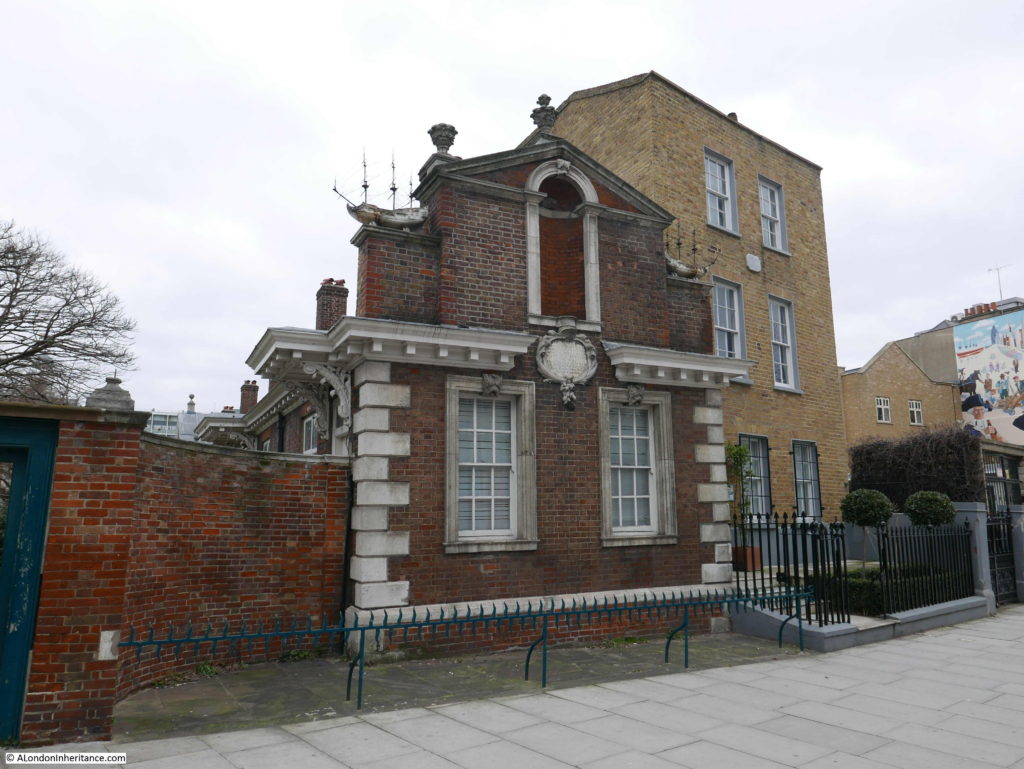

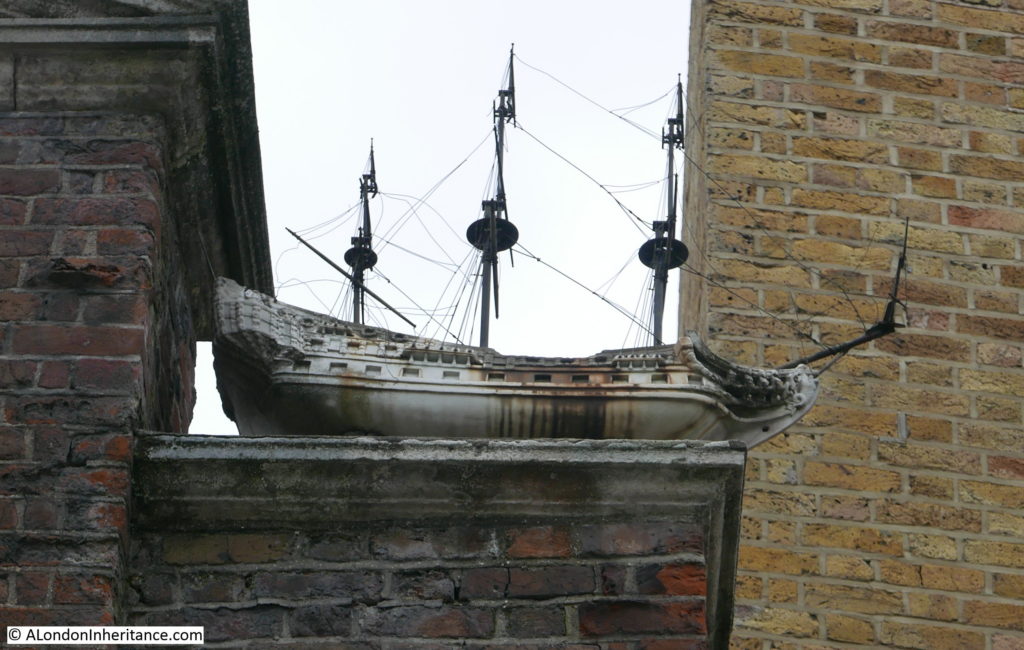
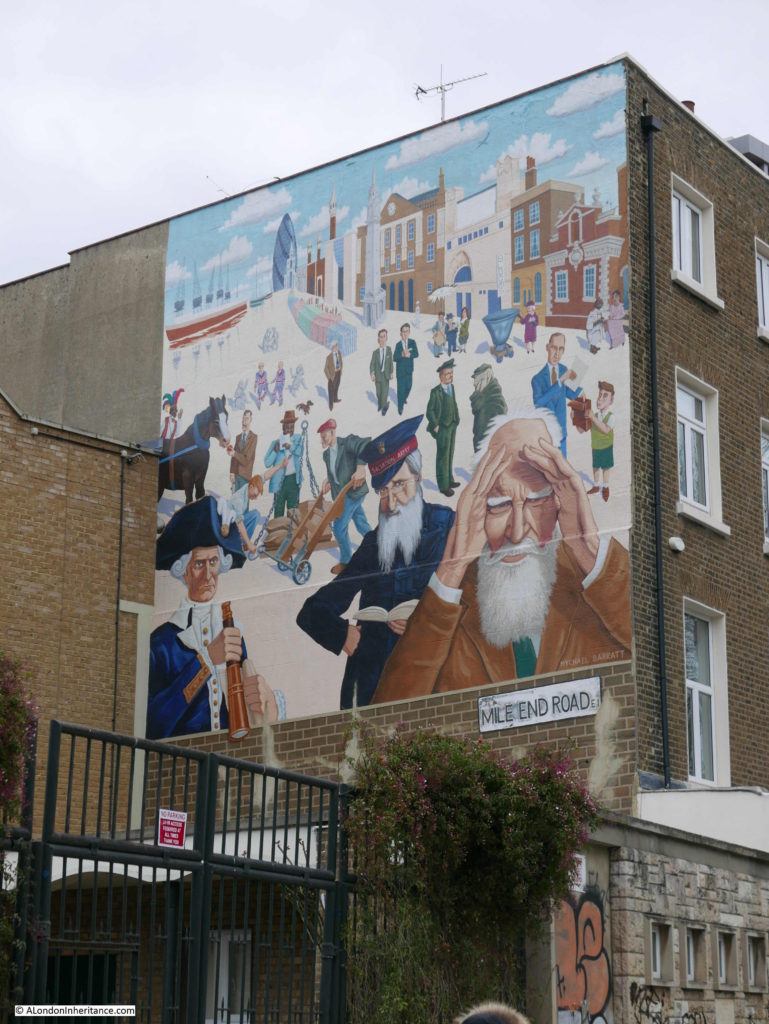
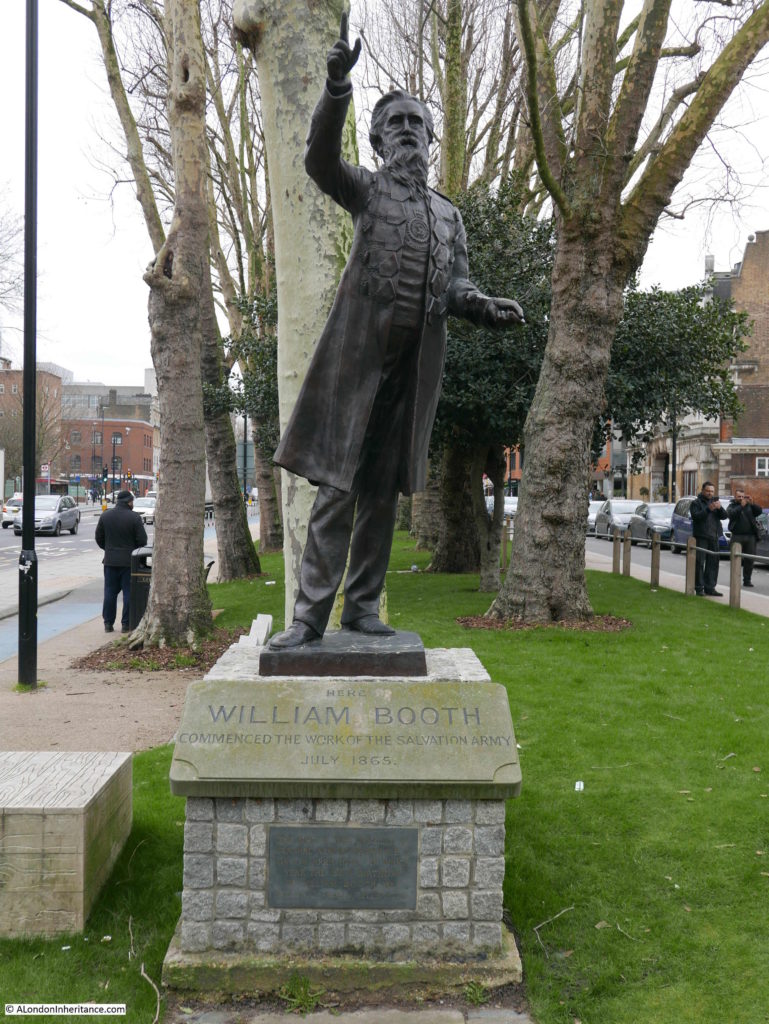


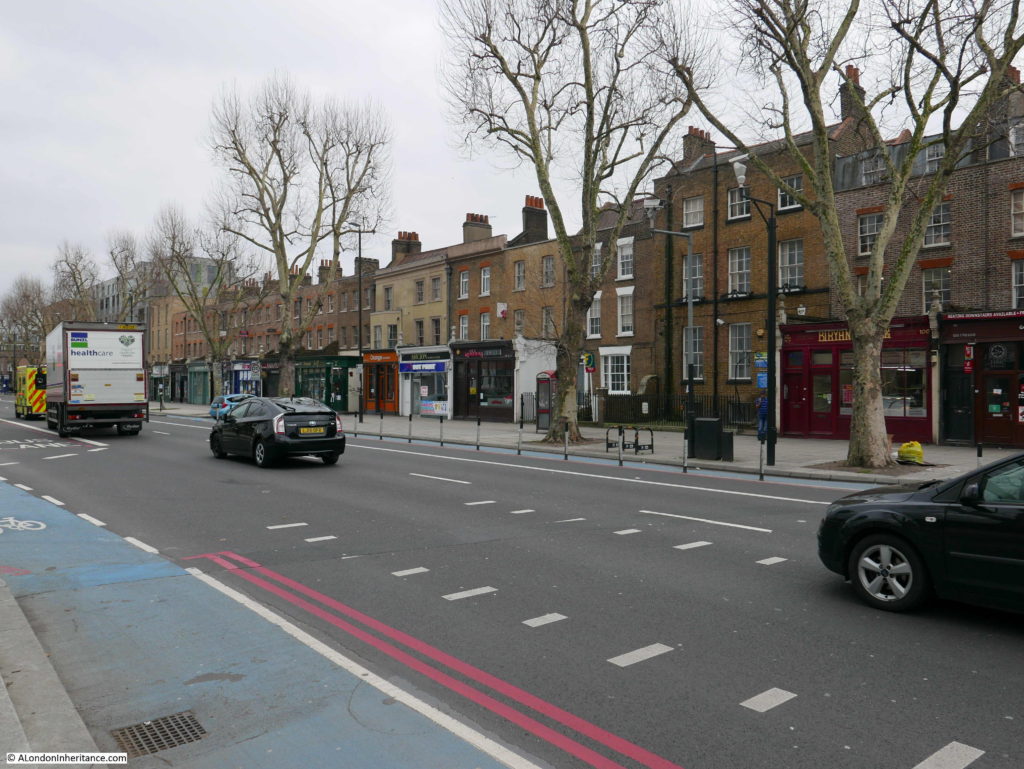
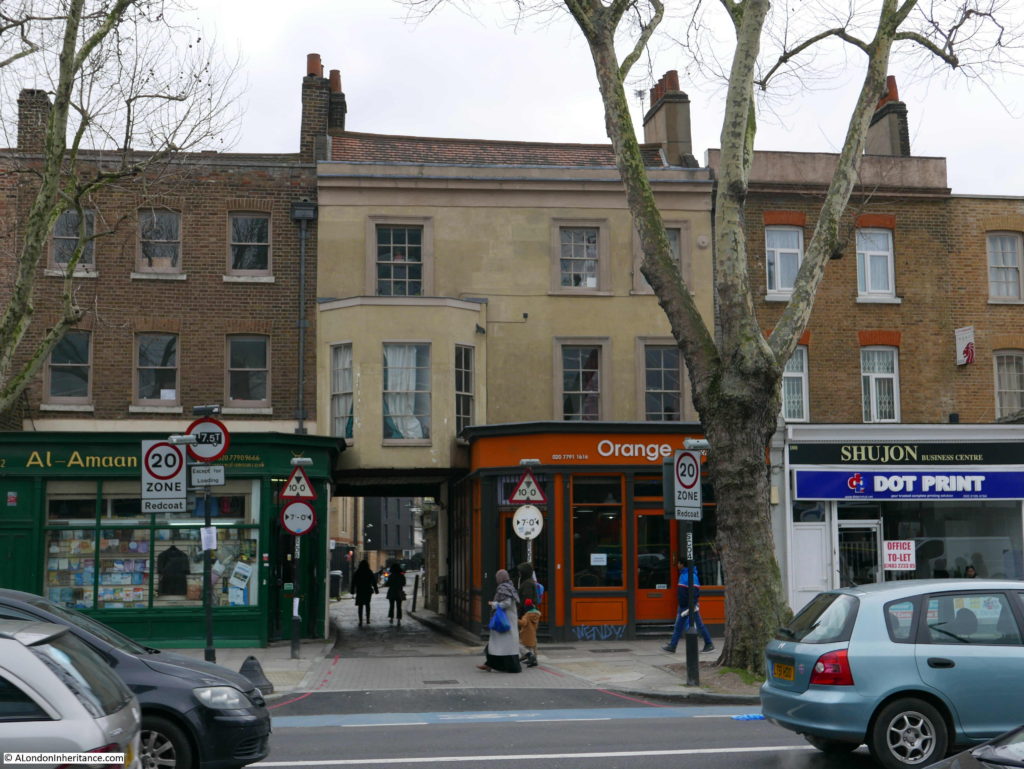

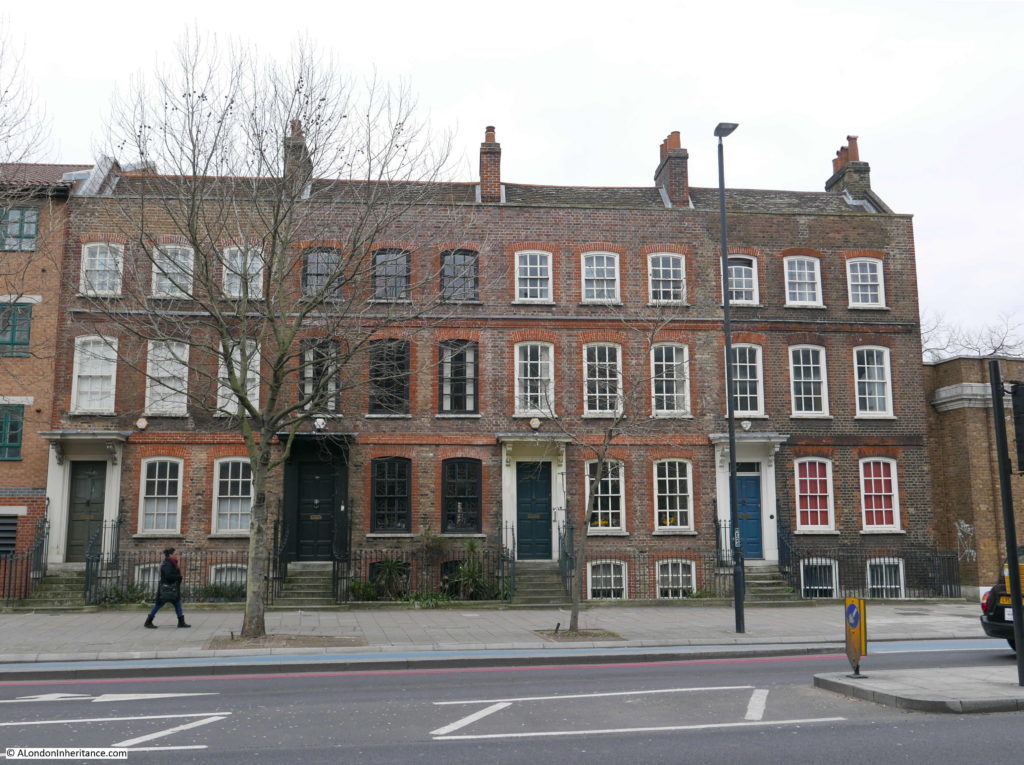
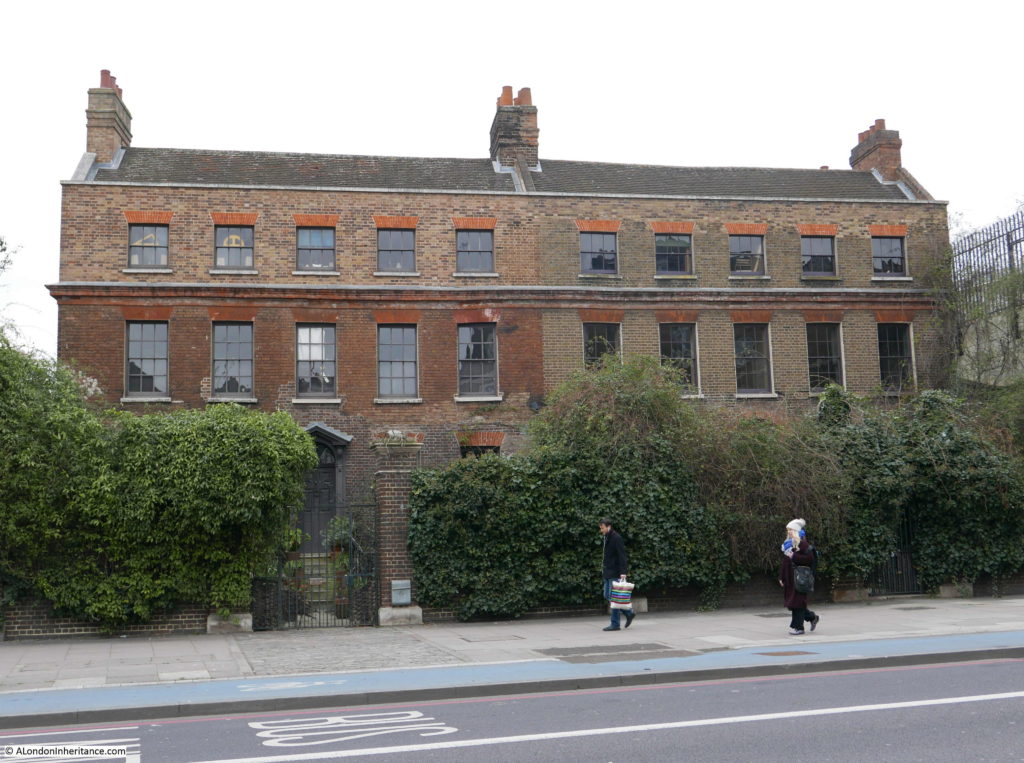
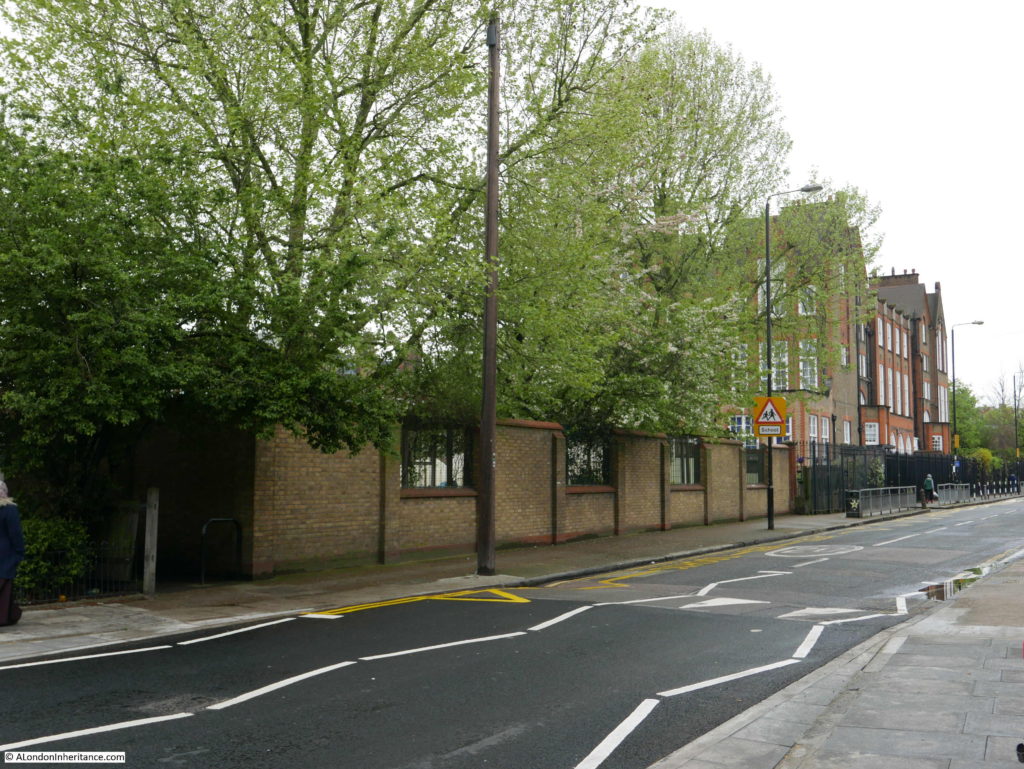
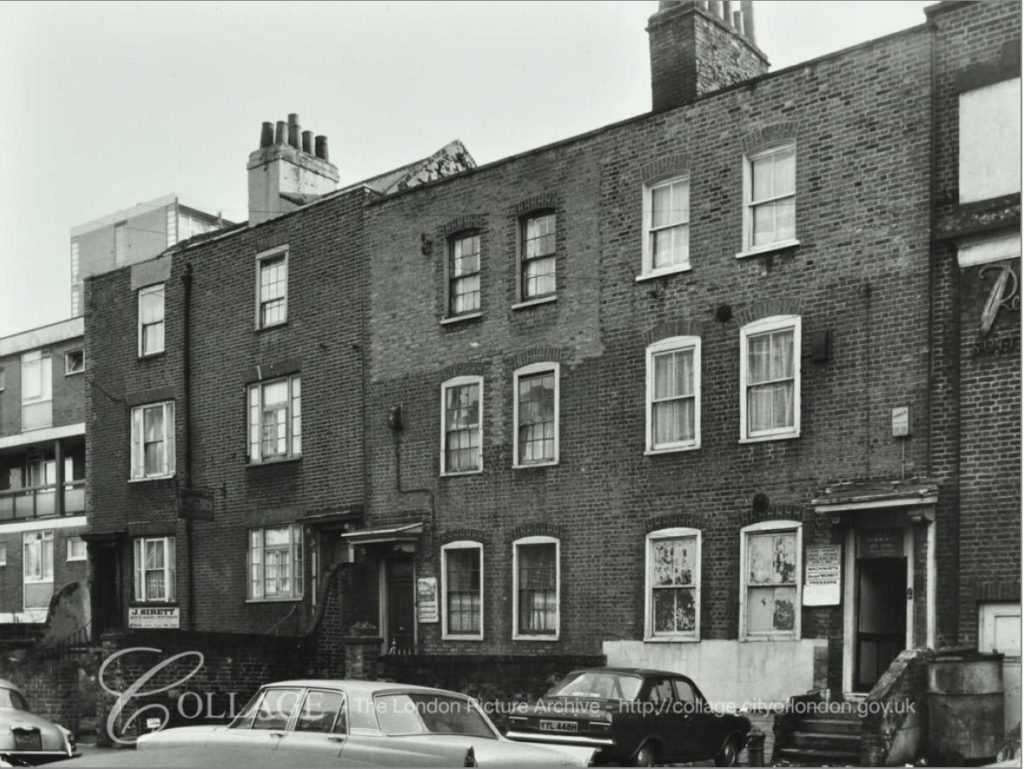
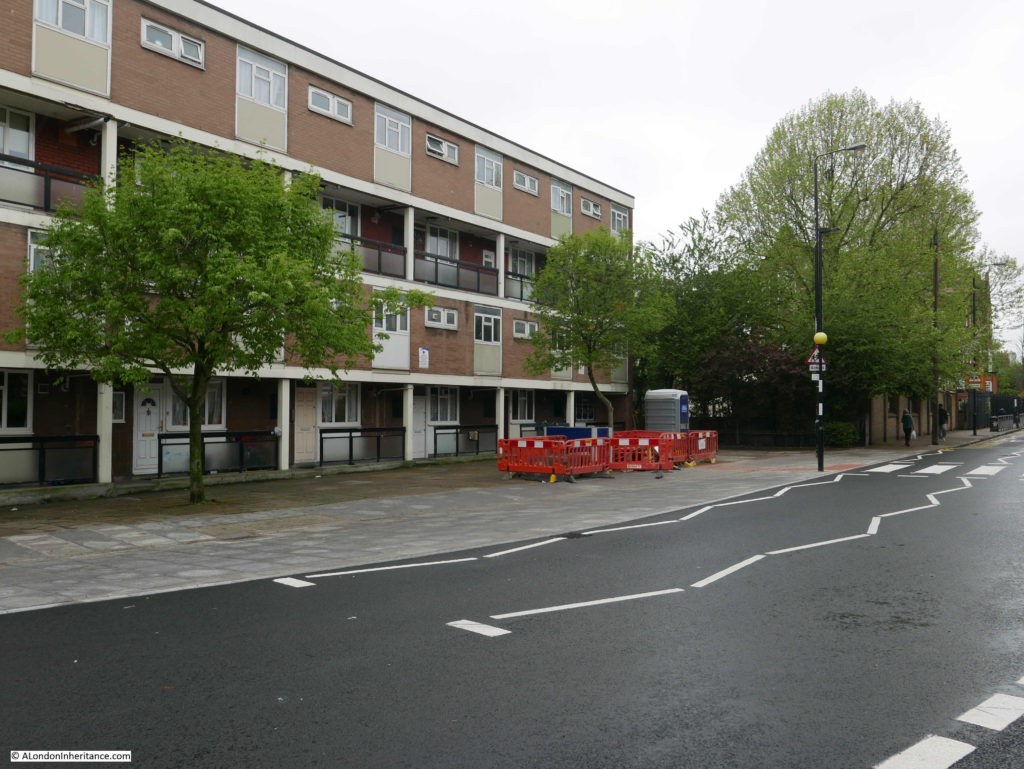
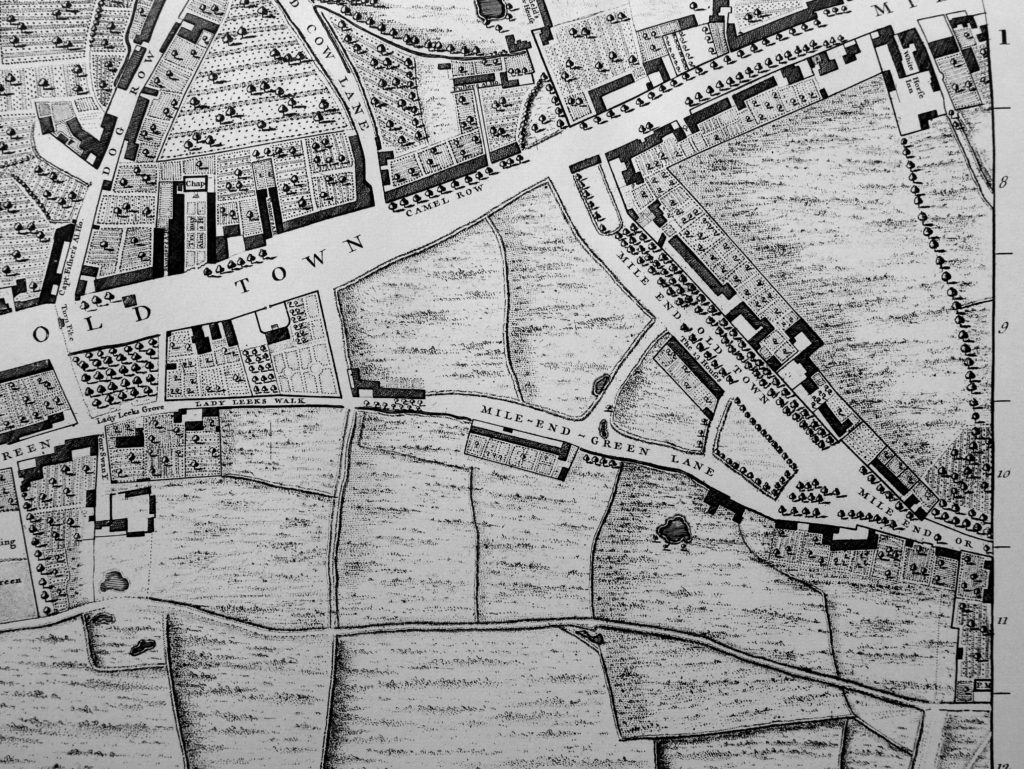
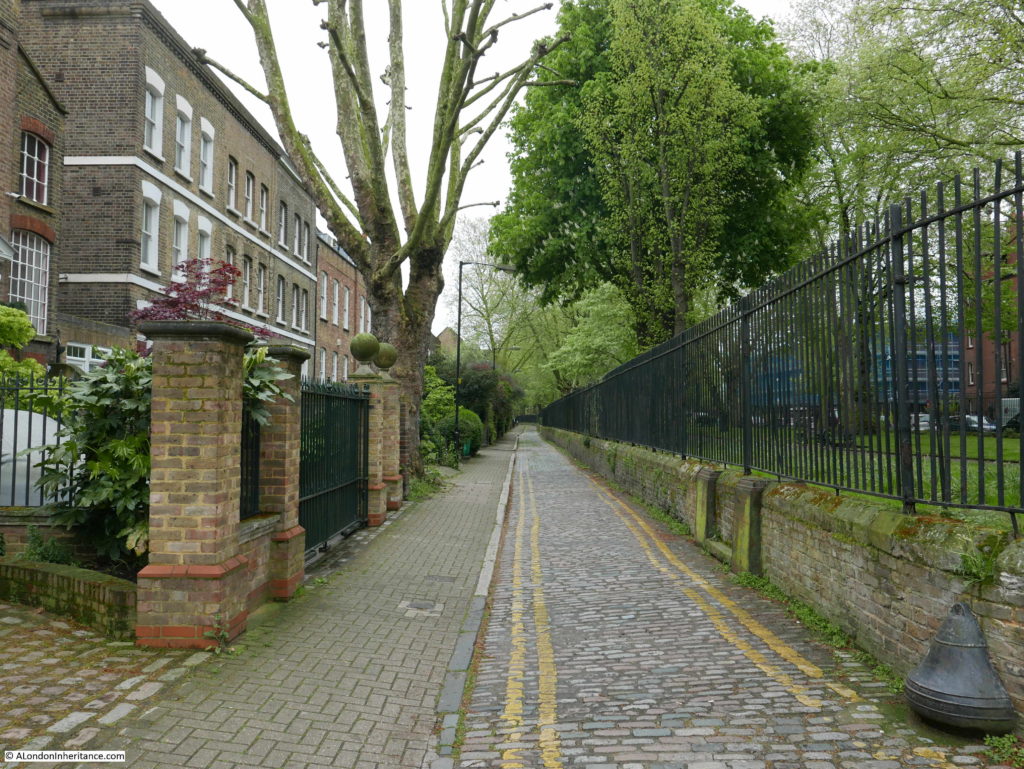

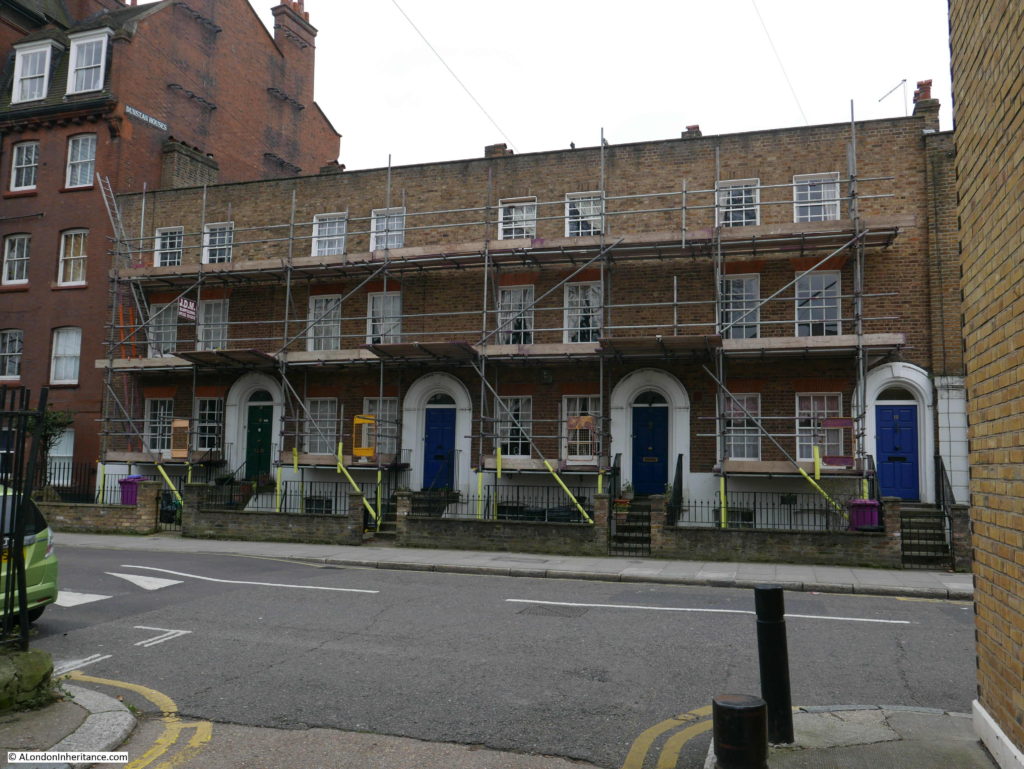
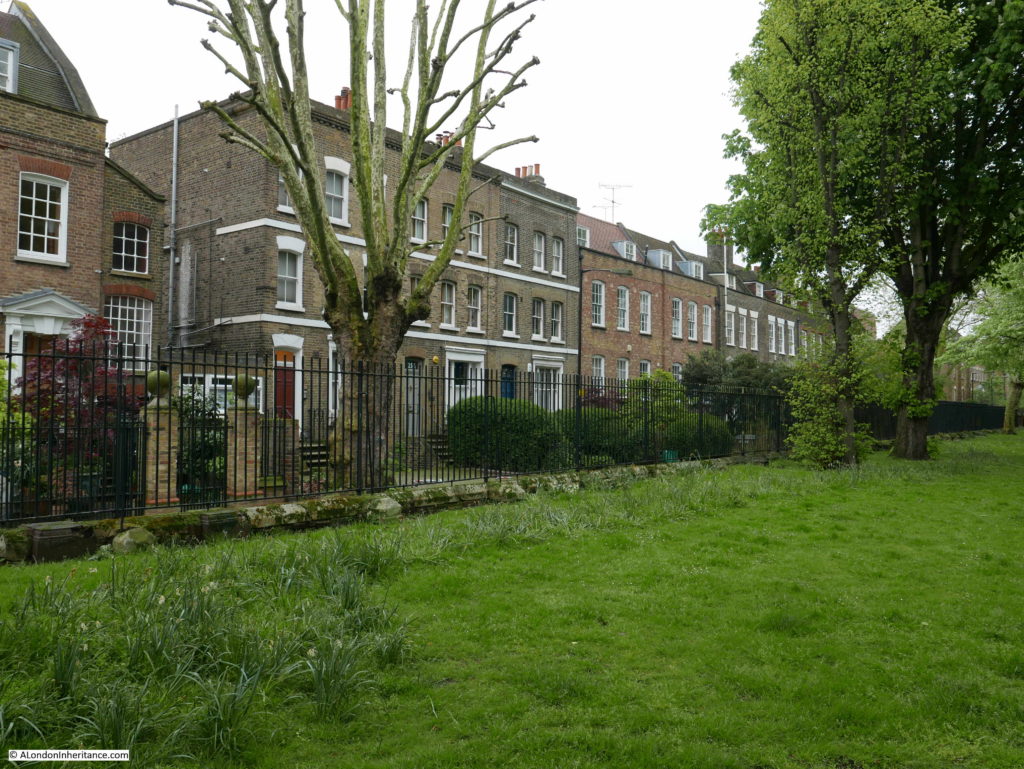
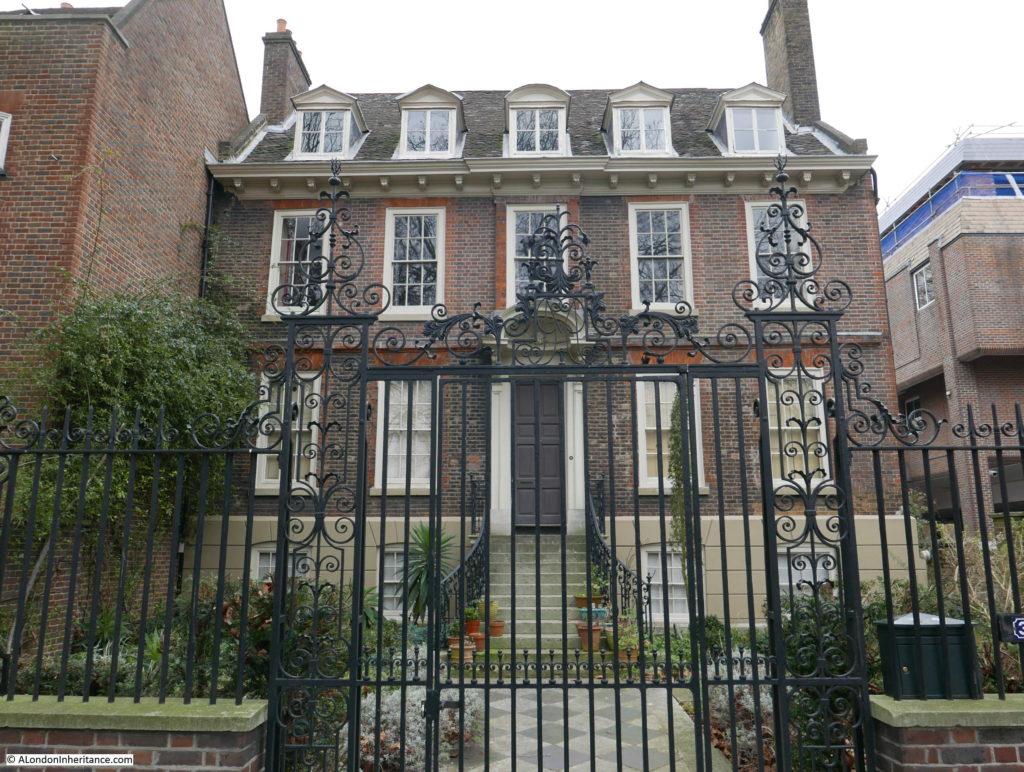
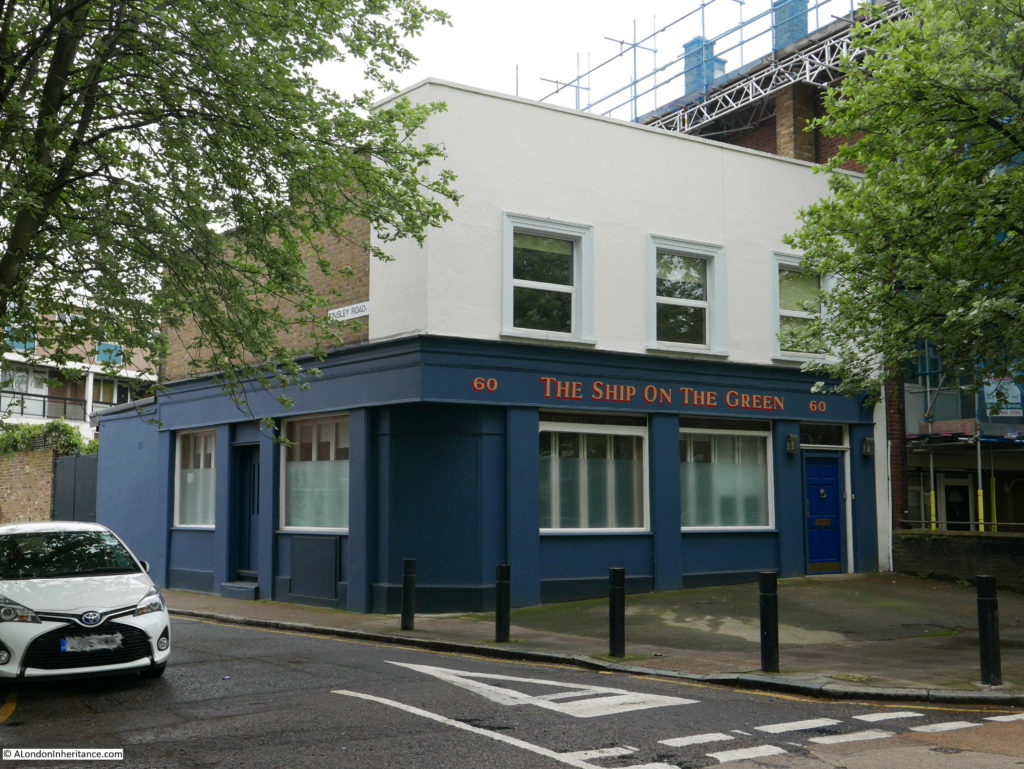
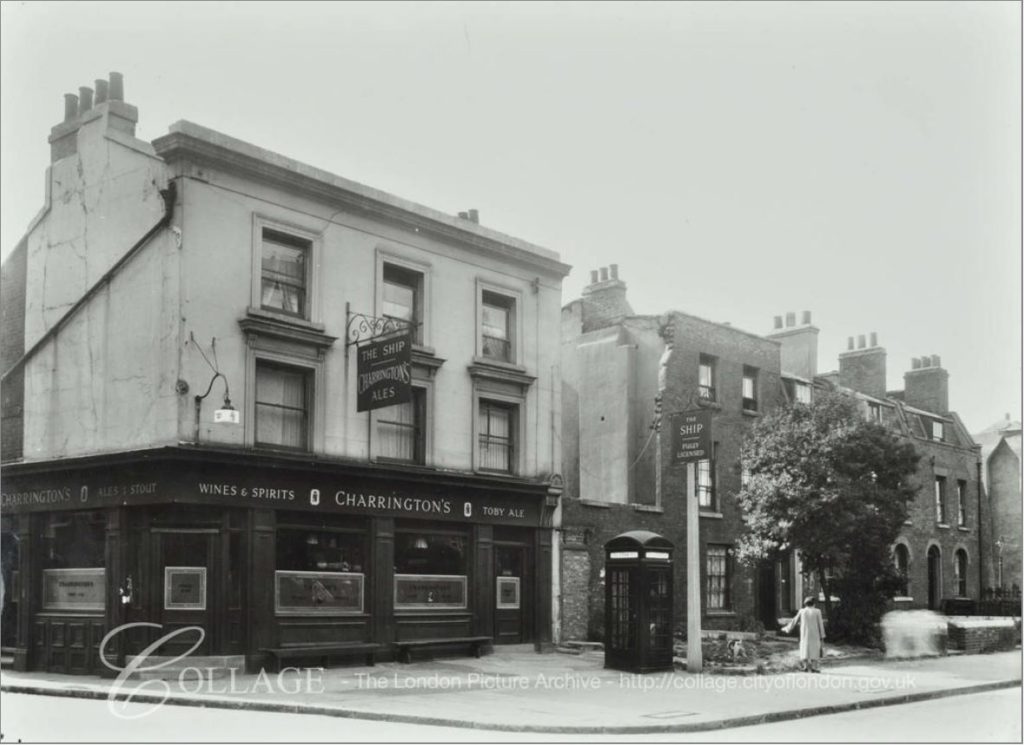



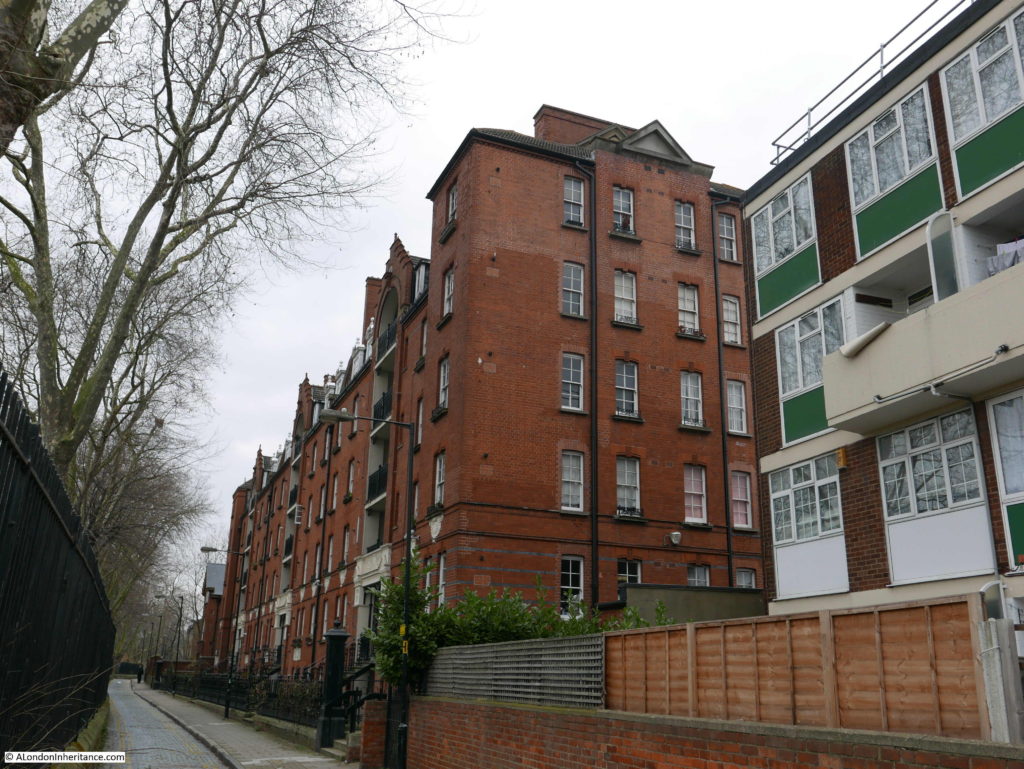
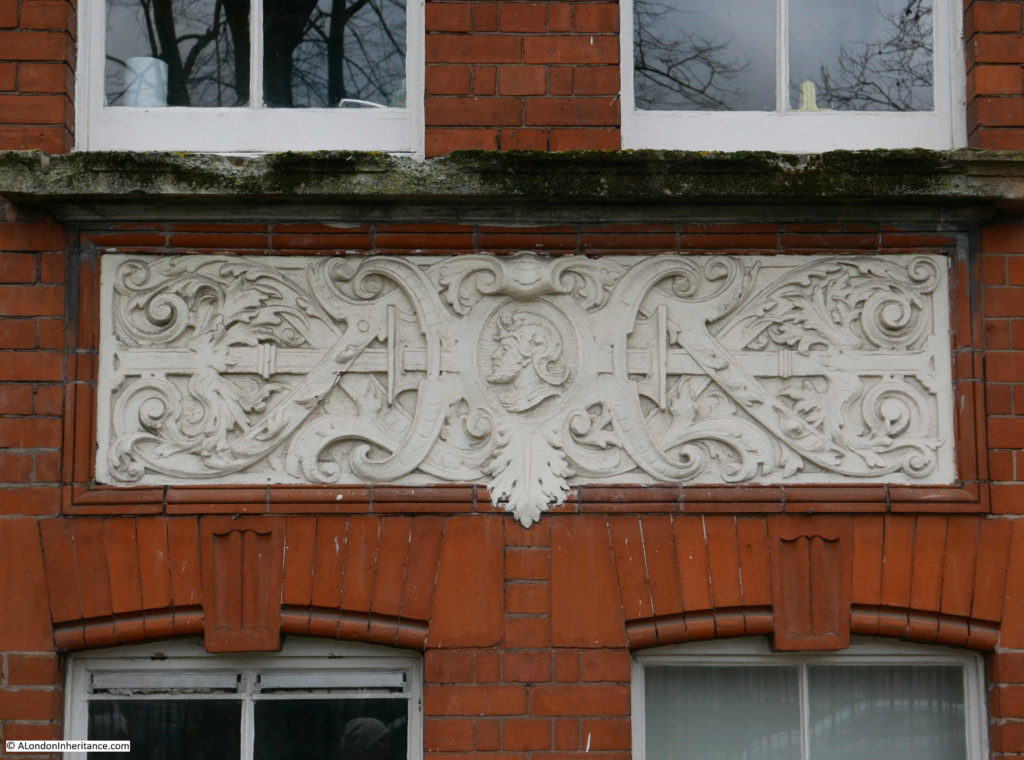
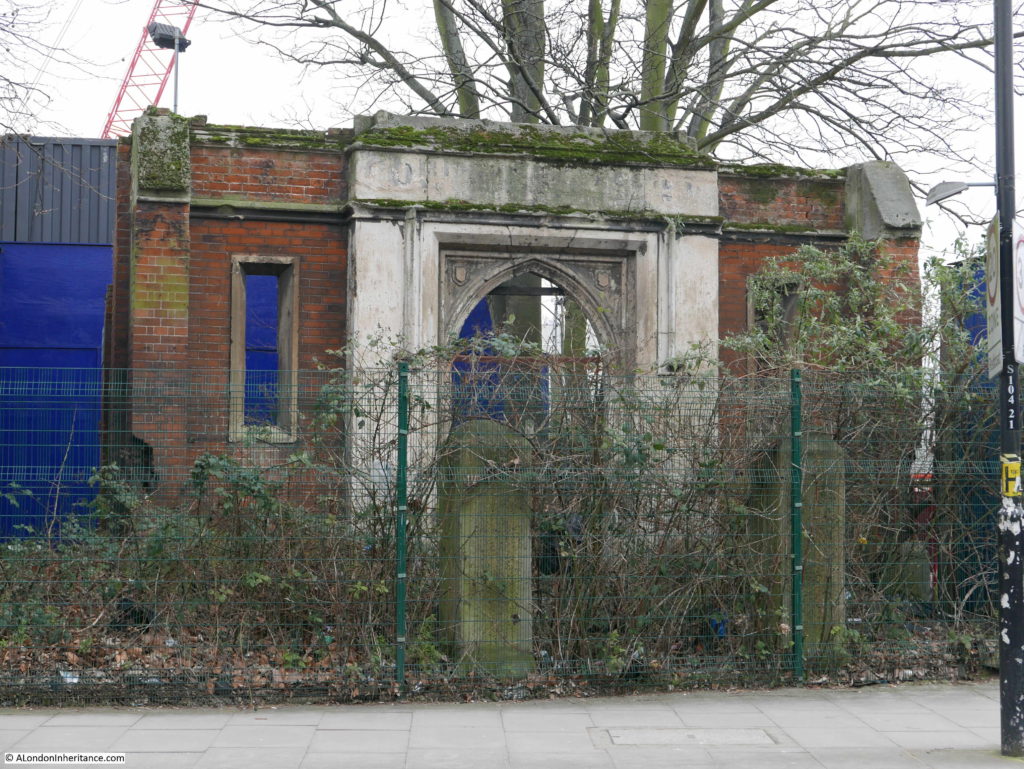
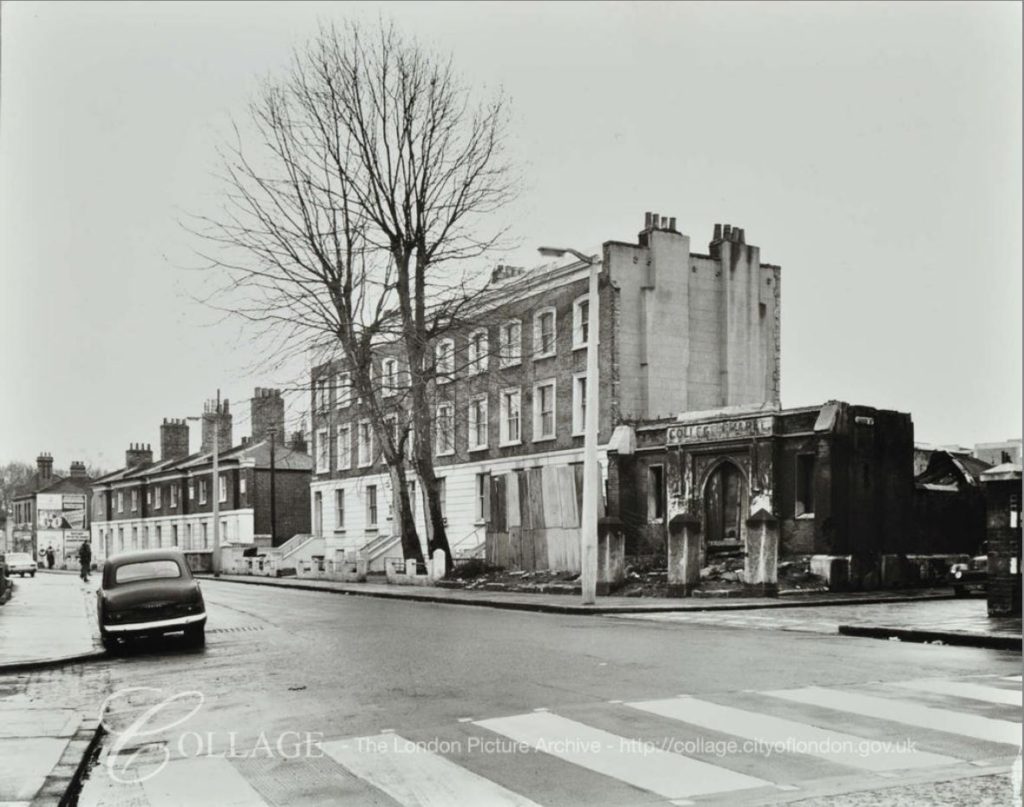
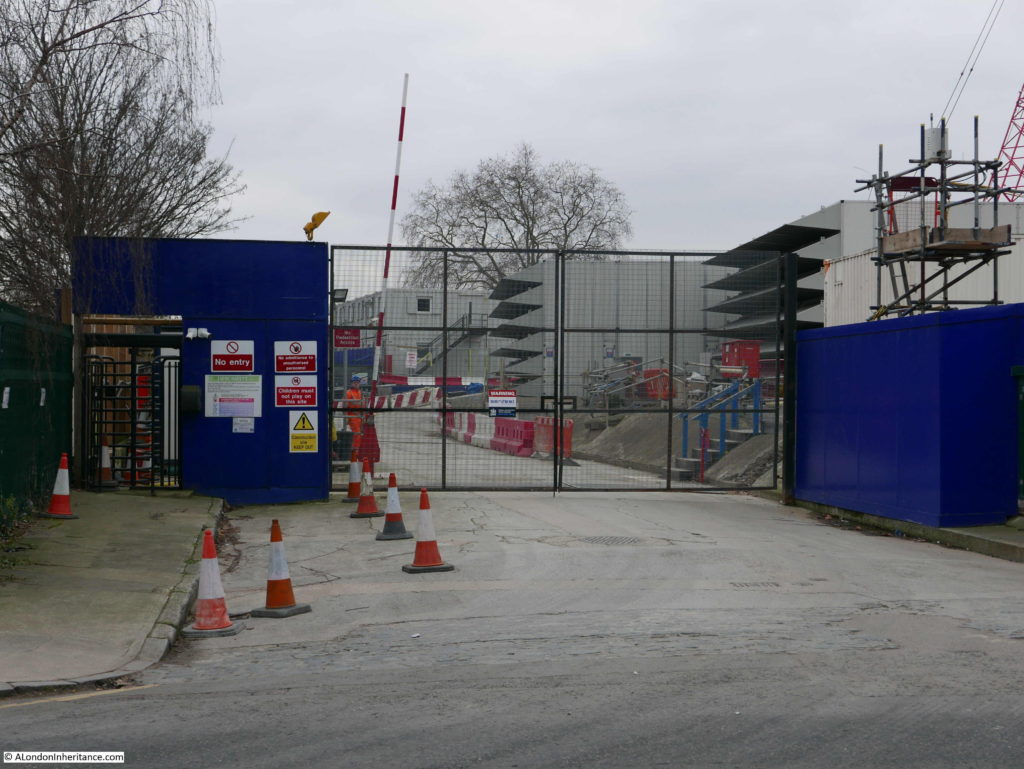
Many thanks
As usual London Inheritance livens up my Sunday mornings
Very interesting post, thank you
Stepney Green is particularly associated with directors of the East India Company (and possibly Hudson’s bay Company, but I’m not sure). No.37, that you photographed, is Geere House, which was home to prominent members of the EIC. Between No.37 and 35 there is an archway that I guess once led to stables at the rear. Until the 1950s there was an LCC ‘open air’ school located through the archway at the rear of the houses, named Geere House School. My mother was a pupil there in the mid-1930s until the pupils were evacuated to Ascot at the start of the war. Geere House was then a Stepney council office. To the right and rear of Geere House was a Jewish hospital. It was eventually demolished and is now a private hospital.
A really interesting – and sometimes depressing – survey of the Mile End area and Stepney Green: I found it particularly depressing that Captain Cook’s House had been demolished for ….a yard! I had thought he had lived in Stepney Green (where I’m fairly certain some acquaintances of mine were squatting in the late 1970’s) so it’s not surprising that no one knew where exactly.
And I never managed to say…as the email shot off too soon…..that your photographs of the area are wonderful and show how much of Tower Hamlets is historic and beautiful. I worked on the Isle of Dogs for 6 years in the early 1980’s and spent many happy hours after work walking around and exploring. It was pre Canary Wharf, and much of the area was in a bad state, with poor rebuilding after WW2 bombing. Happily, it generally looks far better and more cheerful now, and some of the older ‘at risk’ houses have been saved and restored.
Hello! I recently discovered your blog and am loving it! I will be returning to London this autumn for the second time, so doing a little research. Will be staying in the East End, near Stepney. Being a past volunteer docent for the Chicago Architecture Foundation (now Chicago Architecture Center) for 10 years, I can certainly appreciate the work you are doing. While reading your fascinating piece on Stepney Green and St. Dunstan/All Saints, I felt I was walking with you on a discovery tour.
Thanks much!
Can you tell me if Dunstan Buildings School Road Stepney were demolished my Grandparents lived there about 1900 and I can not find any information on thee building.
Kind regards.
My Grandfather was a Caretaker for Dunstans House, Hannibal Road during the very early seventies until his retirement, when he moved to Cressy House, Stepney Green.
I stayed with my Grandparents for 15 weeks when I started my Apprenticeship for the S.E.G.B in 1971 and I had a fantastic time for the duration.
I had the need to return to London yesterday in order to help my Wife to Moorfields Eye Hospital and as we had some time to spare, I thought I’d show her around. and try to remember my youth. I was amazed to see how little had changed since I was last there some 47 years ago, as your pictures clearly show – Happy days !!
Many thanks.
Is there any record of the Mile End Assembly Room? My study has shown it was obviously a place, and this is supported by the street names in the area. I am interested in locating it on the map. It was acknowledged by the historical dance “Mile End Assembly” which was published seven time between 1751 and 1757, and also the “New Mile End Assembly” published in 1768 and 1781. I have found a record of the Rev. Horne delivering an oration there in 1770. Could it have been in the same row of houses (Assembly Row) where Captain Cook lived?
Heather, Derek Morris mentions each of the “new Assembly Rooms at Mile End” (at which tenants met representatives of the Lord of the Manor in December 1766) and the Mile End Assembly Rooms (quoting a newspaper advert from the Daily Advertiser of November 1768) in his book ‘Whitechapel 1600-1800’. In his book ‘Beyond the Tower’ John Marriott tells of large crowds (up to 7500 people) gathering at the Mile End Assembly Rooms in 1769 and a large gathering of Jewish workers at the “Great Assembly Hall, Mile End” in December 1889. It’s possible that Derek will know the location (and he’s also an expert on Captain Cook). I’ve searched other East End books on my bookshelves but all others are silent on the subject.
Thanks, Peter, that’s very helpful. I’m guessing the Assembly Rooms were somewhere between Assembly Row and Assembly Passage? Neither the map from 1746 nor the one from 1767 mark an assembly room, though it would seem to have been a significant place judging from the references. In those days dancing was a significant cultural and social activity – not the trivial pastime it’s become today. I’m exploring the music and dances which were associated with Captain Cook so it’s been fascinating to learn of the Assembly Rooms. I hope to find more information. Would it be possible to contact Derek Morris?
Heather, contact me through my website (www.thehistoryoflondon.co.uk) to provide your email address and I’ll try to put you in contact with Derek.
I lived at 166 Stepney Green from 1952 – now Stepney Farm – until we were moved out in 1968 to Carr Street, overlooking the Regents Canal and the playing fields . I left the East End in 1981 but go back to see how much has changed.
Our row of houses was called College Terrace and you can see the houses in the sorry looking photo showing the chapel. Not the ones with the steps but just further along, there is a photo in the Metropolitan Archives.
As a child I was told it was the site of King John’s Palace, it seems to have been the site of the Great Place where Dean Colet lived, and later Thomas Cromwell, then the Marquess of Worcester. The Museum of London has been excavating there.
So much of the East End, and it’s housing stock was destroyed in the name of ‘slum clearance‘. So misguided and biased. So many communities changed.
Where were The Paragon Mansions that were listed in the 1911 census please? The information is excellent. One of the houses is so similar to the one used in the series Taboo
Debs, is that you? My grandfather lived in Paragon Mansions at the time of the 1911 census.
Hello. My father’s birth certificate in 1905 shows the family living at 29 Paragon Mansions in Mile End Old Town. Do you have any info on the buildings?
Hello – I was just reading this searching for information about my family. Ihave relatives living at 27 Paragon Mansions in the 1901 census. They seem to not be there any longer, but I noted that one street Hayfield Passage which is listed as part of the same group of streets by the census enumerator is still there so I assume they were in this area. It also appears in Charles Booths work on East End poverty. Hope this helps.
Hi. My father’s birth certificate in 1905 shows the family living at no 29 Paragon Mansions in Mile End Old Town. I can’t find any info on the buildings. Have you had any luck?
Hello. I wondered if you had been successful in finding any information on Paragon Mansions. My father’s birth certificate in 1905 shows the family living at 29 Paragon Mansions. I remember reading in a book that kids living in the East End for amusement, would go and watch the poor children living there because they were so poor, no shoes, ragged clothes etc. I haven’t been able to find any info.
I can tell you where they were. At the top of Hayfield Passage was a toy shop called Angels. They were across the road from the Empire Cinema,which was next to Wickhams. Unless you have any inkling of the area descriptions are pointless. I actually lived on Stepney Green from1952 – birth – until 1981, when I moved. My family lived there from around 1890’s until I moved out. If anyone has any queries that I can help with……..
I am trying to post comments and the website is refusing to accept them. Ifanyone wants any information on Stepney Green please contact.
HI Jackie
I am researching family that lived in Stepney Green in 1920 – The address was given as 159 Stepney Green Buildings block G. If you are able to give any idea if where it would have been located I’d be really grateful
Hello Lisa
If you can find Hayfield Passage which runs off Mile End Road and trace it South to where it becomes Stepney Green then 159 will be around that point. I lived at 166 Stepney Green, which was at the corner of Stepney Green and King John Street. Stepney Farm now occupies the site of my former home. There are still ‘dwelling’ building along there.
Hope this helps.
Regards
Jackie
Hi,
I have been trying for many years to find a photograph of The Angel & Trumpet that stood at No 2, Stepney Green. It was bombed in 1940. I have one photograph of my great aunt cleaning the steps of what looks to be a pub, which was taken in the 1930’s. She worked as a barmaid for her uncle who was the licensee of the pub.
Any info would be gratefully received.
The pub, I believe, was actually at 2 Stepney High Street, on the corner of Ben Jonson Road and Stepney Green. I remember the ruins of the pub which we used to play in as children. Stepney Farm is now on the site. Sadly all of my aunts and uncles who lived in the High Street are now dead so there is no one that I can ask.
I found a photo of the house that my grandmother lived in after the bombs demolished the High Street in the London Metropolitan Archive. After the high Street was demolished she lived at 170 Stepney Green, i grew up at 166 Stepney Green.
I hope this helps.
Regards
Jackie Worrow
Hi whilst tracing my family tree i found that my GGG grand father lived at Mile End – green.
Has anyone any recollections of the area, and is this now Stepney green ? or Mile End
Many thanks
Terry
Mile End Green and Stepney Green are synonymous. My grandmother and her children -6- lived in Stepney High Street. After the bombs in WW2 they moved from the High Street to 170 Stepney Green. We lived at 166 Stepney Green from before my birth until 1969. The High Street had been oblitorated.
If you need anything specific let me know I will help where I can.
Regards
Jackie W
I wonder if anyone has news of friends of mine who
used to live at 11 Redmans Road, Stepney Green,
London, E 1.
The surname was Taylor, during the 60’s.
I now live in Brisbane, Queensland.
Jimmy W.
,
Hello,
I keep coming across your blog on my hunt for more information on an ancestor’s home: ‘Heath House’ built in 1800 on Commercial Road – the site is now a school which was built in 1907. I have been able to locate it on a map but can’t seem to find any photos or paintings of the house which must have been quite a large house on the corner, with a large walled garden. Have you ever heard of it?
Juli B
Hi, I wonder if you have any pictures or any knowledge of 31 Stepney Green Industrial Home as per the 1891 Census, I have recently found a “relative” living thre as a boarder/scholar.
Thanking you in advance
Jen Adams
Jenny, are you sure it is No.31? Unless the numbering in Stepney Green has changed, No.31 is a large Georgian family home. The Industrial Dwellings are further along on the same side but with higher numbers (I’m guessing in the numbers 60s or 70s). I recently took some photos of them.
Hi Peter
Thank you for your reply – I have double checked the 1891 Census entry and it’s definitely listed as an Industrial Home situated at 31 Stepney Gardens.
The Matron is a Mary J Roberts and the residents of the home are listed over 2 pages, my relative is listed on the second page.
Jen
It sounds like a different type of establishment to the Industrial Dwellings Society apartment building that is still there. As I said before, the current No. 31 is a family home, I guess built in 18th century. It must have either been that house, or the street numbering has been changed.
Hi Peter, who knows!
I did think when I checked the street out on google maps the houses there looked more residential than institutional if you know what I mean. Normally you can tell from the outside if a house used to be a workhouse/school or other establishment, perhaps Matron Roberts was working for an independent society, we shall never know and my relative seems to disappear after 1891… Oh well another brick wall to add to the many I have collected over the years..
Dear Jenny
I think you are referring to the Industrial Home Society Dwellings, rather than a ‘home’. They are still there . The term scholar was a descriptive term for someone attending school, I was called a scholar, aged 5/6 when I opened a post office savings account in 1957, or there abouts. A number of Dwellings appeared along Stepney Green in the 1880’s to provide for the sudden explosion of population. The Baptists had founded a college there which relocated to become Regents Park College. Our house, on the corner of King John Street and Stepney Green was the end of College Terrace, the ruins of College Chapel are still there. Hope this helps.
Regards
Jackie Worrow
Hi Jackie, many thanks for reply to my enquiry so quickly.
I have double checked the address on the 1891 Census for Mile End Old Town and it’s definitely 31 Stepney Green (the entry is over 2 pages of the census return) – Mary J Roberts is listed as the Matron of “Industrial Home” on the first page and my relative is listed as a boarder and scholar aged 10yrs is on the second page.
Jen
Jenny, probably worth checking a map from the 1890s and comparing it with Google maps to see if it is the same building.
Hi Jenny, i’ll try and do some Checking, and get back to you.
Regards
Jackie
Thank you, have a good Easter, Jen
Hello again Jen
Have you checked with the local history library at Bancroft Road Library? An excellent repository of archives and local history books for Tower Hamlets. Exten
Regards
Jackie
Check the East London Advertiser, local weekly newspaper. Been around for years, literally, and has a good archive.
Regards
Jackie